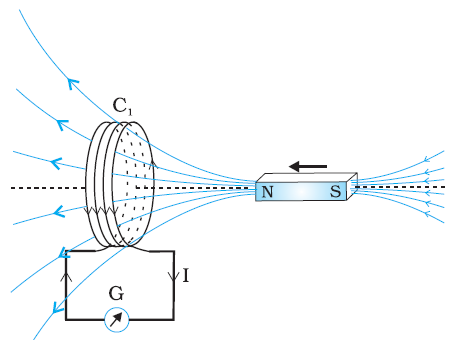
Describe one experiment to demonstrate the phenomenon of electromagnetic induction.
Answer
573.9k+ views
Hint
The phenomenon of generation of electric current by causing a variation in the magnetic field is electromagnetic induction. Faraday conducted an experiment in which a coil connected to a galvanometer is placed near a bar magnet. The movement of the bar magnet towards or away from the coil causes the generation and flow of electric current in the coil.
Complete step by step solution
The phenomenon of electromagnetic induction was first discovered by Michael Faraday while experimenting on how to produce an electric current in a circuit using only the force of the magnetic field. Faraday noticed that moving a permanent magnet in and out of a coil induces an electromotive force thereby producing current.
The experiment conducted by faraday is described in brief as follows:
In the experiment, a coil denoted by ${{\rm{C}}_1}$ is connected to a galvanometer, and a bar magnet is placed near to it as shown in the figure.

When the bar magnet is held stationary, the galvanometer does not show any deflection. When the north pole of the magnet is pushed towards the coil, the pointer in the galvanometer deflects indicating the presence of an electric current in the coil. However, when the north pole of the magnet is pulled away from the coil, the pointer in the galvanometer deflects in the opposite direction, indicating that the direction of the current is reversed. Similarly, when the south pole of the magnet is moved towards or away from the coil, the galvanometer deflects in a manner opposite to that observed when the north pole of the magnet was moved towards or away from the coil. When the coil is pushed towards and pulled away from the fixed bar magnet, the same effects of deflections in the galvanometer are observed. The relative motion between the magnet and the coil ${{\rm{C}}_1}$ changes the magnetic flux associated with the coil. This induces an electromotive force in the coil. This induced emf causes the electric current to flow in the coil and through the galvanometer.
Note
When the bar magnet is not moving away or towards the coil, no sign of deflection is seen in the galvanometer implying the non-induction of current in the coil.
The phenomenon of generation of electric current by causing a variation in the magnetic field is electromagnetic induction. Faraday conducted an experiment in which a coil connected to a galvanometer is placed near a bar magnet. The movement of the bar magnet towards or away from the coil causes the generation and flow of electric current in the coil.
Complete step by step solution
The phenomenon of electromagnetic induction was first discovered by Michael Faraday while experimenting on how to produce an electric current in a circuit using only the force of the magnetic field. Faraday noticed that moving a permanent magnet in and out of a coil induces an electromotive force thereby producing current.
The experiment conducted by faraday is described in brief as follows:
In the experiment, a coil denoted by ${{\rm{C}}_1}$ is connected to a galvanometer, and a bar magnet is placed near to it as shown in the figure.

When the bar magnet is held stationary, the galvanometer does not show any deflection. When the north pole of the magnet is pushed towards the coil, the pointer in the galvanometer deflects indicating the presence of an electric current in the coil. However, when the north pole of the magnet is pulled away from the coil, the pointer in the galvanometer deflects in the opposite direction, indicating that the direction of the current is reversed. Similarly, when the south pole of the magnet is moved towards or away from the coil, the galvanometer deflects in a manner opposite to that observed when the north pole of the magnet was moved towards or away from the coil. When the coil is pushed towards and pulled away from the fixed bar magnet, the same effects of deflections in the galvanometer are observed. The relative motion between the magnet and the coil ${{\rm{C}}_1}$ changes the magnetic flux associated with the coil. This induces an electromotive force in the coil. This induced emf causes the electric current to flow in the coil and through the galvanometer.
Note
When the bar magnet is not moving away or towards the coil, no sign of deflection is seen in the galvanometer implying the non-induction of current in the coil.
Recently Updated Pages
Two men on either side of the cliff 90m height observe class 10 maths CBSE

What happens to glucose which enters nephron along class 10 biology CBSE

Cutting of the Chinese melon means A The business and class 10 social science CBSE

Write a dialogue with at least ten utterances between class 10 english CBSE

Show an aquatic food chain using the following organisms class 10 biology CBSE

A circle is inscribed in an equilateral triangle and class 10 maths CBSE

Trending doubts
Why is there a time difference of about 5 hours between class 10 social science CBSE

Write a letter to the principal requesting him to grant class 10 english CBSE

What is the median of the first 10 natural numbers class 10 maths CBSE

The Equation xxx + 2 is Satisfied when x is Equal to Class 10 Maths

Which of the following does not have a fundamental class 10 physics CBSE

State and prove converse of BPT Basic Proportionality class 10 maths CBSE




